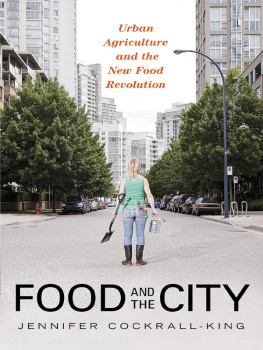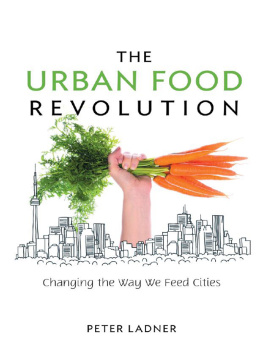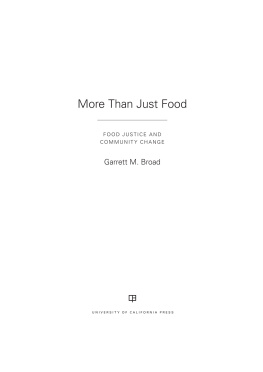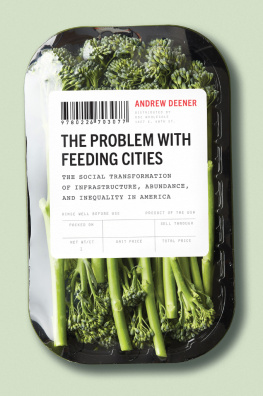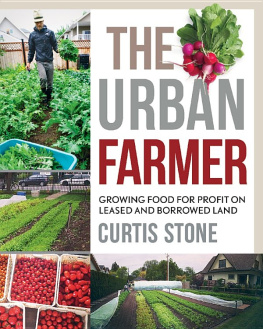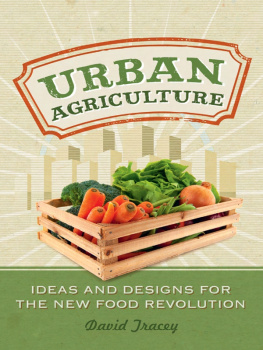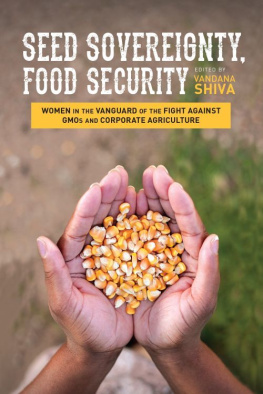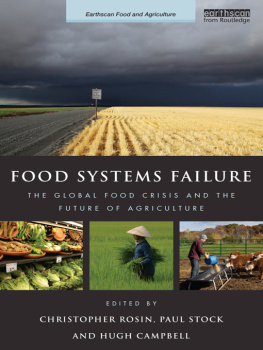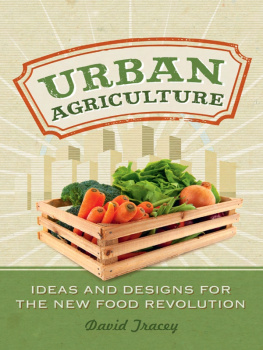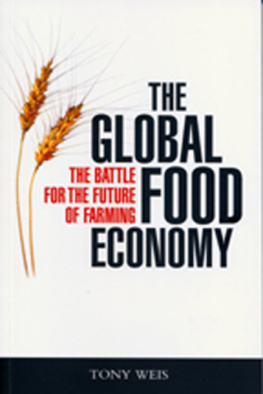
W riting a book is a humbling marathon. I could not have done this without a large network of support and assistance from family, friends, colleagues, and (to my delight and surprise) complete strangers, who took the time to answer questions or provide information, just for the love of urban agriculture and good, locally grown food. To thank everyone who helped me get from the initial idea to the final book would be too much, but every last piece of advice, interesting fact, helpful connection, and word of encouragement to keep writing helped make this book become a reality.
One of the greatest pleasures I got while researching and writing this book was to meet so many passionate people in urban agriculture, food systems, and urban food gardening. I will always treasure the new friends I met along the way who gave their time and energy toward helping me understand why they do what they do. Each and every one, in her and his own way, helped me realize that while growing a few heirloom veggies in the front yard, tending a community orchard, or keeping a beehive on a condo rooftop may seem like an insignificant thing on its own, it is these little actions of self-reliance and community self-sufficiency that are at the forefront of the new food revolution. More importantly, the world is a richer, and tastier, place for your important work. To them, I simply say: keep growing.
There are a few people I wish to acknowledge by name: Mifi Purvis and Craille Maguire Gillies for being my sounding boards, especially during the early rumblings of this project; Adria Iwasutiak, the supreme literary networker; and my sincerest thanks to my agent, Chris Bucci at Anne McDermid & Associates, for being in love with the idea for the book from the beginning and trusting that I could see it through its long journey. And to the entire team at Prometheus Books, which shepherded this book from draft manuscript to beyond the bookshelf, my eternal gratitude for your guidance and contributions.
Above all, I need to thank my husband, Mike. This book couldn't have been completed without you shouldering more than your half of the load and allowing me the time to write. And for the daily offerings of help, which usually meant delivering plates of food and countless cups of tea to my desk, I love you.
Lastly, I got a significant lift during the final months of preparing this manuscript when I got a phone call letting me know that I was the winner of the 2011 Dave Greber Freelance Writers Award, a Canadian book and magazine prize that helps independent writers bring social justice issues to light. Thank you for getting the connection between food and social justice, and for finding my book worthy of the prize.

Ableman, Michael. On Good Land: The Autobiography of an Urban Farm. San Francisco, CA: Chronicle Books, 1998.
Brown, Celia Brooks. New Urban Farmer, From Plot to Plate: A Year on the Allotment. London: Quadrille Publishing, 2010.
Despommier, Dickson. The Vertical Farm: Feeding the World in the 21st Century. New York: Thomas Dunne Books, 2010.
Fraser, Evan D. G., and Andrew Rimas. Empires of Food: Feast, Famine, and the Rise and Fall of Civilizations. Toronto, ON: Free Press, 2010.
Funes, Fernando, Luis Garca, Martin Bourque, Nila Prez, and Peter Rosset. Sustainable Agriculture and Resistance: Transforming Food Production in Cuba. New York: Food First Books, 2002.
Honor, Carl. In Praise of Slow: How a Worldwide Movement Is Challenging the Cult of Speed. Toronto, ON: Vintage Canada, 2004.
Johnson, Lorraine. City Farmer: Adventures in Food Growing. Vancouver, BC: Greystone Books, 2010.
Kropotkin, Peter. Fields, Factories and Workshops. Montreal: Black Rose Books, 1994.
Millstone, Erik, and Tim Lang. The Atlas of Food: Who Eats What, Where, and Why. Berkeley: University of California Press, 2008.
Mougeot, Luc J. A., Growing Better Cities: Urban Agriculture for Sustainable Development. Ottawa, ON: International Development Research Centre, 2006.
Nordahl, Darrin. Public Produce: The New Urban Agriculture. Washington, DC: Island Press, 2009.
Nestle, Marion, Food Politics: How the Food Industry Influences Nutrition and Health. 2nd edition. Berkeley: University of California Press, 2007.
Palassio, Christina, and Alana Wilcox. The Edible City: Toronto's Food from Farm to Fork. Toronto, ON: Coach House Books, 2009.
Patel, Raj. Stuffed and Starved: The Hidden Battle for the World's Food System. Toronto, ON: Harper Perennial, 2009.
. The Value of Nothing: Why Everything Costs So Much More than We Think. Toronto, ON: HarperCollins, 2009.
Pollan, Michael. In Defense of Food: An Eater's Manifesto. New York: Penguin Press, 2008.
. The Omnivore's Dilemma: A Natural History of Four Meals. Toronto, ON: Penguin, 2007.
Richardson, Jill. Recipe for America: Why Our Food System Is Broken and What We Can Do to Fix It. Brooklyn, NY: Ig Publishing, 2009.
Roberts, Wayne. The No-Nonsense Guide to World Food. Oxford, UK: New Internationalist Publications, 2008.
Rubin, Jeff, Why Your World Is about to Get a Whole Lot Smaller. Toronto, ON: Vintage Books, 2010.
Schlosser, Eric. Fast Food Nation: The Dark Side of the All-American Meal. New York: Houghton Mifflin, 2001.
Staten, Clifford L., The History of Cuba. New York: Palgrave Macmillan, 2003.
Steel, Carolyn. Hungry City: How Food Shapes Our Lives. London, UK: Vintage Books, 2009.
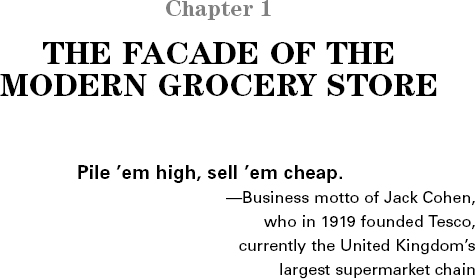
THE SUPERMARKET
N o matter how philosophically locavore (trying to source only locally grown and raised food), or how pro-farmers markets I am, I still find myself pushing a shopping cart up and down the aisles of a supermarket a couple times a week.
I'm remarkably typical, as it turns out. According to the Food Marketing Institute, an Arlington, Virginia-based grocery retail association representing three-quarters of all retail grocery sales in the United States, the average supermarket shopper makes 1.7 trips to the supermarket per week.
First of all, supermarkets are undeniably convenient. They are generally open seven days a week, and some chains and locations stay open twenty-four hours a day. I know what's available even before I get there, and most of the food is cheap. That said, if I'm willing to splurge a bit, I can also get strawberries in January. No wonder this is how the majority of us get our groceries.
The Rise of the Supermarket
For such a monopolistic hold on our food dollars, you'd think that supermarkets had been around since the dawn of time. It's difficult for us to conceive of how it could be otherwise, so it's shocking to think that they've been around for barely four generations. Academic, food-justice activist, and writer Raj Patel points out in his book Stuffed and Starved: The Hidden Battle for the World's Food System, [S]upermarkets are patented inventions, and like all innovations, they responded to a specific need at the time and place of their conception.
At the turn of the twentieth century, the industrialized nationsand the United States in particulargot very good at producing things, including food. With tractors, combines, and other mechanized farming equipment rather than plow-horses and human labor as the limiting factor of their workday, farmers could clear, plant, and harvest a much larger area, working bigger farms than ever before. They specialized to maximize the usefulness of their equipment and turned from being producers of a wide variety of crops and livestock on a farm (mixed farming) to specializing in as little as one single grain, pulse, or oilseed (monocrop farms). Readily available chemical fertilizers, pesticides, and other chemical treatments to the soil enabled single-crop plantings, which otherwise would exhaust the soil within a few harvests, just as antibiotics allowed concentrated feedlots that would otherwise render livestock sick and unsuitable for slaughter and sale. Farms essentially became factories that specialized in the efficient production of a narrow range of productsbut in large quantities at a low unit price.
Next page
